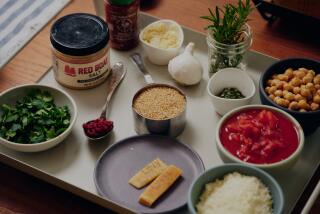Plain or Fancy
Loving chickpeas is like loving someone plain. Friends donŌĆÖt really get it. Sure, chickpeas are perfectly respectable, yet theyŌĆÖre slightly boring and no cause for making a fuss. ThatŌĆÖs why I was surprised to find myself in conversation about them with chef Johannes Bacher of Johannes, probably the most interesting restaurant in Palm Springs.
After a dinner there, I asked him about the deliciously creamy herbed mousse he had served with bread at the beginning of the meal. It turned out that the base was chickpeas, but the texture had fooled me--smooth and without the graininess of hummus (which is great in its own way, of course). Bacher is a fan of chickpeas and their versatility: ŌĆ£You can make a crust out of chickpeas for meats and fish, you can use them in soup, in salads, in sauces. TheyŌĆÖre in Oriental dishes, Middle Eastern recipes. A chickpea curry would be great, with green beans and tofu--you could serve fried bananas with it. That would be awesome.ŌĆØ
Apparently, Italians have reacted with similar enthusiasm. The Roman orator Cicero said proudly that his family took its name from the chickpea (the Latin name is Cicer arietinum). In the 13th century, it is said that the Sicilians revolted against French rule and killed anyone who couldnŌĆÖt pronounce the Italian word for chickpea (a dead giveaway that they were foreigners).
You can find chickpea recipes throughout the Mediterranean, but the earliest records of cultivated chickpeas are from Turkey. Their slightly sweet, chestnut-like flavor means that they can go anywhere chestnuts can go, from appetizers to entrees to desserts. ThereŌĆÖs a traditional Italian recipe from the Abruzzi region for a sweet ravioli filled with chickpea puree. The puree is mixed with chocolate, walnuts, honey and citrus; it takes a lot of time to prepare, but itŌĆÖs worth it.
IŌĆÖve always thought of chickpeas as the perfect bachelor ingredient: a can of chickpeas, a can of tuna and an onion, and you have the makings for a classic antipasto. A can of chickpeas, a can of tomatoes, some dried rosemary and a chicken bouillon cube, and you have all you need for an Italian soup. Chickpeas go well with strong flavors, asserting their mellowness in amiable partnership with what could be overpowering companions: anchovies, garlic, hot peppers, and in curries or with chocolate.
One of my favorite chickpea recipes is from Sicily, a pasta with a sauce that owes a lot to Moroccan cooking. It tastes of hot weather, itŌĆÖs easy to make and it could never be considered boring.
*
Pasta and Chickpeas
Serves 4
1/3 cup olive oil
2 tablespoons minced jalapeno pepper (leave in seeds for more heat)
5 cloves garlic, thinly sliced
1 teaspoon paprika
1/4 cup sweet red or yellow pepper, thinly sliced
1 cup fresh tomatoes, seeded and chopped (or 1 cup diced canned tomatoes)
1 cup canned chickpeas
1 pound spaghetti
Salt and freshly ground pepper to taste
Heat the oil in a large saute pan. Saute the jalapeno pepper and garlic over medium-high heat for about 1 minute, stirring to keep the garlic from burning. Add the paprika and sweet pepper, and continue to stir until softened, about 2 minutes. Raise heat and add the tomatoes and chickpeas. Stir for 1 minute, then lower the heat and simmer, covered, for 5 minutes.
Cook the pasta until almost al dente (slightly undercooked), drain and toss with the sauce. Continue cooking in the sauce for about 30 seconds more, then cover, remove from heat and let stand until the liquid is absorbed and the pasta is cooked al dente, about 2 minutes. Season with salt and freshly ground pepper to taste.


